Eagle Rays: Family Myliobatididae
Species: Myliobatis californica (Gill, 1865); from the Greek words myl (a tooth or molar), io (an arrow or poison), batis (a skate or ray) and the Latin word Californica (referring to location). Apparently called aetobatus californica at one time in California: CA Fish Bulletin #28.
Alternate Names: Stingray, stingaree, bat sting ray, sea ray, eagle ray, batfish, big black, sea bird, flapper, rat tailed stingray, NASCAR, mud marlin (my favorite), and monkey face ray. Called raya murciélago or tecolote in Mexico.
Identification: Bat rays have a very heavy raised head and a dorsal fin at the base of a long whiplike tail with a stinger just behind it. Their coloring is blackish or blackish brown above and white below. Beware of the stinger.
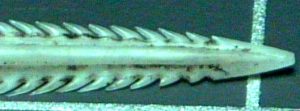
The stinger on a bat ray can be very painful
Size: Reported to reach nearly six feet across and over 200 pounds. Most bat rays caught from piers are less than fifty pounds but many in excess of a hundred pounds are caught every year.
Although we’ve had several reports over the years of bat rays weighing 200 pounds or more, the official state (and world) record remains a fish that weighed 181 pounds 0 ounces. It was caught at the Huntington Beach Pier on July 24, 1978 by Bradley A. Dew, a senior at Huntington Beach High School. Records indicate it was 23 pounds over the prior record and, according to the Dept. of Fish and Game, the fish had a 5 1/2-foot-wingspan, a 3-inch-long stinger, and the width across the bat ray’s eyes was an even ten inches.
A 240-pound bat ray was reported from Newport Bay in 1957. I received a note on the Pier Fishing in California Message Board of a 246-pound fish with an 8.5-foot-wing span that was reputedly taken from the Newport Pier in the ’80s. However, the width sounds too wide leaving the weight also in doubt. I’ve seen pictures of a 176-pound bat ray taken from the Newport Pier and a 175-pound bat ray that was caught at the Aliso Beach Pier in (I believe) 1990.
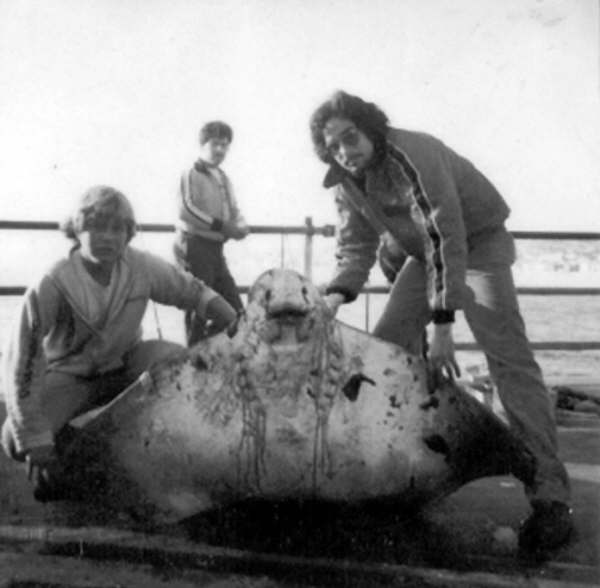
Bat ray taken at the Hermosa Beach Pier in the ’70s by Mola Joe
Another fish, this one weighing 203 pounds and measuring 54 ½ inches wide was measured and weighed on a certified scale. It was caught at the Stearns Wharf in Santa Barbara on April 24, 2004. The fish struck a live smelt bait and was landed after a fight lasting one hour and twenty minutes. The fish was hooked and fought by James Elledge, and gaffed by Ron Maxell. With the help of bait shop owner Ray Angel (how appropriate) the fish was carried over to the Santa Barbara Shellfish Company to their certified scales. PFIC representative Boyd Grant was soon on the scene to witness and photograph the huge fish…one of the largest bat rays ever caught on a California pier (and possibly the largest to be weighed on a certified scale).
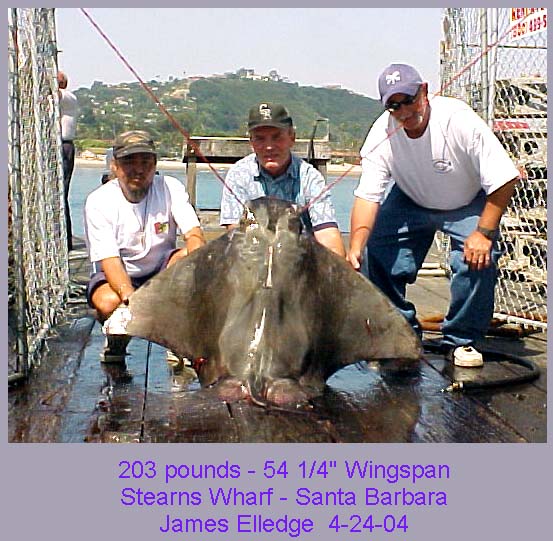
This fish was seen and the information verified by UPSAC member (and head of the Goleta Pier Angler’s Center) Pierhead (Boyd Grant). We never determined why it did not qualify as a record.
According to the California DF&G “female bat rays reach a greater size than males, attaining a maximum disc width of 70.9 inches and weight of 210 pounds. The largest reported male is 40 inches wide and a weight of 37 pounds. Bat rays grow slowly, reach sexual maturity relatively late, have few young, and seem to be fairly long-lived. A 60-inch disc width female was estimated to be 24 years old.” So, all of the big bat rays are moms, grandmas or maybe even great grandmothers.
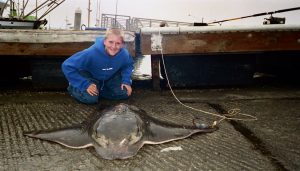
Big bat ray taken at the North T-Pier in Morro Bay.
Range: Gulf of California to Yaquina Bay, Oregon. Common from Bahia Magdalena, southern Baja California, to Arcata Bay and Humboldt Bay in northern California.
Habitat: Prefers a flat, rocky bottom or sand among rocks although also seems to enjoy hanging around kelp beds. Most commonly caught in sandy or muddy bottom bays and the deeper water areas around piers. Bat rays basically “fly” through the water using their powerful pectoral fins and occasionally they will leap out of the water when hooked. Most common in intertidal waters but recorded to a depth of 577 feet.
Piers: Bat rays are caught at almost all piers in California, both oceanfront and those in bays. Best bets: Shelter Island Pier, San Clemente Pier, Balboa Pier, Newport Pier, Huntington Beach Pier, Redondo Beach Pier, Hermosa Beach Pier, Stearns Wharf, Cayucos Pier, Berkeley Pier, San Mateo Pier, Elephant Rock Pier, Angel Island Pier, Eureka Municipal Wharf and Del Norte Street Pier (Eureka).
Shoreline: A frequent catch of shore anglers from San Diego Bay to Humboldt Bay.
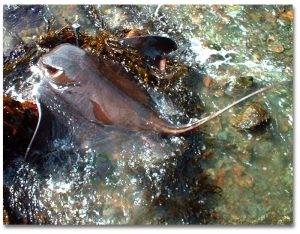
Boats: A frequent catch by boaters and kayakers fishing in almost every California bay.
Bait and Tackle: Bat rays eat a wide variety of foods with oysters, clams, crabs, shrimp, abalone, snails and worms being scarffed down on a regular basis. To be expected, they’ll also take almost any bait. However, frozen or live squid, and live bait such as anchovies, ghost shrimp, mud shrimp and grass shrimp, produce most of the fish. Frozen squid is the least expensive and easiest bait to use and is undoubtedly the number one bait for bat rays.
It’s reported by the way that these strong rays use their pectoral fins to lift their body rapidly up and down to create a suction that sweeps away the sand and gives easy access to their food on the bottom. Because of the potential large size, anglers wishing to fish specifically for bat rays should use heavy tackle and have a net available to bring the fish up onto the pier. NEVER use a pier gaff to lift them up to a pier unless you’re intending to keep them for food.
Food Value: Good although cleaning can be a task.
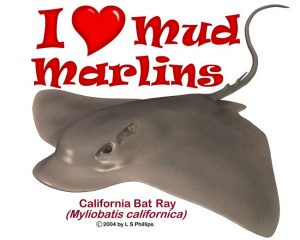
Comments: Although Ray Cannon’s book How To Fish the Pacific Coast holds a cherished spot on my library shelf, and in many ways was a model for Pier Fishing In California, I believe he was wrong in his comments on bat rays. His most egregious was that “These giant Bat Rays should be exterminated whenever possible because of their menace to crabs, lobsters, and all kinds of edible shellfish.” Although it’s true that those species may be included in a bat ray’s diet, I’m not sure why they were singled out over predators. I think it reflects the thinking of the day, in particular the opinion that bat rays were a danger to commercial oyster operations, i.e., those in Tomales Bay. We know today that they are not a danger to those operations; in fact, they may help by keeping crabs under control. I’m not sure why he made a second statement, an assertion that bat rays are “Seldom taken by anglers.” Even back in those days bat rays (usually called sting rays, or in earlier days stingarees) were a common catch, and several shark and ray derbies were conducted along the coast, the most famous probably being that at Moss Landing. For years PFIC/UPSAC had a Mud Marlin Derby at the Berkeley Pier where sometimes more than a hundred anglers would be seeking out the big rays. Today, many anglers concentrate on bat rays. The rays reach a very large size, they put up a strong fight, and are delicious to eat once the fight is over (although more and more people practice catch-and-release with them).
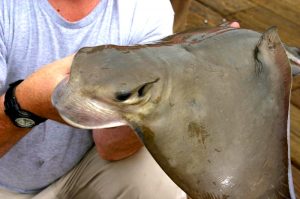
Of interest are the bat ray pools found at several aquariums (including the Monterey Aquarium, The Aquarium Of the Pacific, and the Chula Vista Nature Center). The bat rays can be petted and in fact are rather pet-like; some even seem to like to have their backs stroked. Yes, their stingers have been removed! The venomous spines are cut off about once a month (before they reach a length long enough to hurt anyone). Apparently the bat rays receive no harm from these “manicures,” in fact the spines are made of keratin, the same substance found in human fingernails, and the spines grow back. However, bat rays in the wild still have their spines and can inflict a painful wound, so be very careful if you catch one (and some bat rays have two or even three stingers). For some reason Stearns Wharf in Santa Barbara sees a lot of small, immature bat rays and they’re usually called monkey face rays.
Scientists report that bat rays move into inshore waters to breed during the summer then tend to move offshore in the winter (so guess when they are more likely to be caught from a pier). While inshore, they are sometimes found in large concentrations. At times these bat ray gatherings contain several thousand individuals. The sea bottom holding these creatures must look a little weird and would certainly have a somewhat alien feeling; not sure if it would be more like a black-cloaked Darth Vader convention, a Raider Nation convention, or something even more outlandish (and scary), a political convention.
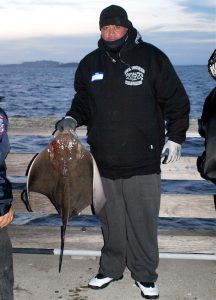
Bat Ray—Many large bat rays are caught every year.
≈ 220 Lbs. — Ventura Pier, early ‘80s; Source: PFIC
203 Lbs. — Stearns Wharf (Santa Barbara), James Elledge, April 24, 2004; Source: Personal comm. Boyd Grant; PFIC
≈ 200 Lbs. — Huntington Beach Pier, May 2014; Source: Let’s Go Fishing, Huntington Beach Pier
≈ 200 Lbs. — Huntington Beach Pier, December 2009; Source: Let’s Go Fishing, Huntington Beach Pier
≈ 200 Lbs. — Oceanside Pier, April 2006; Source: Oceanside Pier Bait Shop
≈ 200 Lbs. — Seal Beach Pier, March 2001; Source: Big Fish Bait & Tackle, Seal Beach
≈ 200 Lbs. — Ocean Beach Pier, August 1998; Source: PFIC
≈ 200 Lbs. — Hermosa Beach Pier, “Mola Joe”, 1980s; Source: PFIC
≈ 200 Lbs. — Carpinteria Pier, Bill Hinckley, September 18, 1955; Source: Los Angeles Times, September 19, 1955
≈ 200 Lbs. — Redondo Wharf No. 1, June 25, 1888; Source: Los Angeles Herald, June 27, 1888
181 Lbs.* — Huntington Beach Pier, Bradley. A. Dew, 1978
Source: Los Angeles Times, July 28, 1978 & California Dept. of Fish and Wildlife * = Official state record fish and world record (IGFA)
175 Lbs. — Aliso Beach Pier, August 1984; Source: Aliso Beach Pier Snack Shack
≈ 170 Lbs. — Seal Beach Pier, May 2001; Source: Big Fish Bait & Tackle, Seal Beach
169 Lbs. — Hermosa Beach (pier?), July 30, 1912; Source: Oakland Tribune, July 30, 1912
160 Lbs. — Ocean Beach Pier, May 2009; Source: PFIC
≈ 160 Lbs. — Seal Beach Pier, March 2001; Source: Big Fish Bait & Tackle, Seal Beach
≈ 150 Lbs. — Oceanside Harbor Pier, August 2009; Source: PFIC
150+ Lbs. — Santa Monica Pier, May 2008; Source: Santa Monica Pier Bait Shop
150 Lbs. — Santa Monica Pier, May 2002; Source: Santa Monica Pier Bait Shop
≈ 150 Lbs. — Oceanside Pier, April 2001; Source: Oceanside Pier Bait Shop
≈ 140 Lbs. — Seal Beach Pier, March 2001; Source: Big Fish Bait & Tackle, Seal Beach
135 Lbs. — San Clemente Pier, June, November 1999; Source: PFIC
125 Lbs. — Huntington Beach Pier, Greg Taite, April 1999; Source: Let’s Go Fishing, Huntington Beach Pier
123 Lbs. — Huntington Beach Pier, Robert Gerber, March 1999; Source: Let’s Go Fishing, Huntington Beach Pier
120 Lbs. — Ocean Park Pier, Stuts Baida, July 1927; Source: Los Angeles Times, July 31, 1927
110 Lbs. — Pine Avenue Pier (Long Beach), William Crowder, June 2, 1907; Source: Los Angeles Herald, June 2, 1907
106 ½ Lbs. — Belmont Pier (Long Beach), Bill Kerny, October 13, 1960; Source: Long Beach Independent, October 14, 1960
104 Lbs. — Rainbow Pier (Long Beach), Dave Feske, October 13, 1960; Source: Long Beach Independent, October 14, 1960
100+ Lbs. — Stearns Wharf (Santa Barbara), June 1997; Source: Mike’s Bait & Tackle, Stearns Wharf, June 1997
≈ 100 Lbs. — Santa Cruz Municipal Wharf, Walter Cartwright, April 11, 1934; Source: Santa Cruz Sentinel, April 12, 1934
100 Lbs. — Seal Beach Pier, April 1958; Source: Long Beach Independent-Press Telegram, April 13, 1958
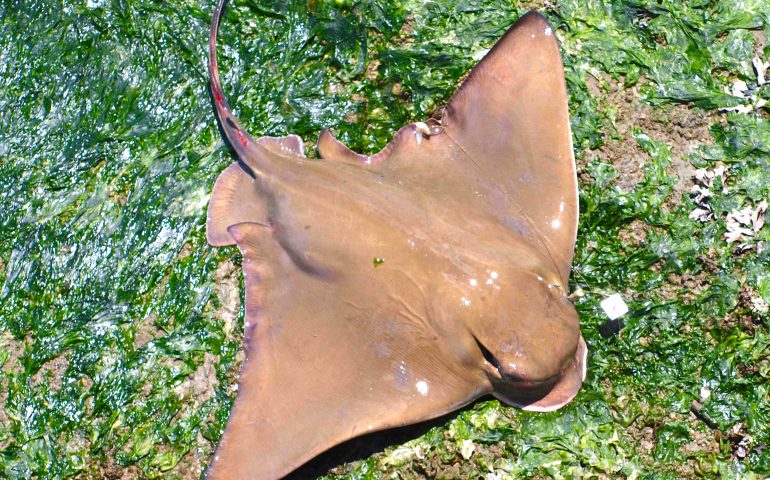
Catching this things on a public pier is a prize catch. The people love to see them and the comments keep coming. I’ve never seen anyone keep one although I always imagined they’re tasty. Releasing them is always the norm as they are always said to be an important part of the eco system. Cool catch. Great article. Thx.
I always practice Catch and Release with Bat rays. I enjoy targeting them when pier fishing and use a hoop net to land AND release each one. I have caught Bat rays recently at Seal Beach, Belmont Memorial and Cabrillo Beach piers respectively. In the past I also caught my first Bat ray at Aliso Beach pier.
Thankyou for your well written and informative article. It’s strange that the record hasn’t been updated in light of all the other large Bat Rays caught. Of course there’s always cases like my son’s too. He caught a big Bat Ray in San Diego last June, 24, 2023. After it broke his scale, it weighed in at 191 pounds on someone else’s tuna scale. Then he just took it home and processed the meat to eat later. He did save the jaws. It’s Huge, I can send you a picture of it if you like. He’s holding it up with a stainless steel gaff. He’s an athletic 6’1” Marine. The biggest one he got before that was a 94 pounder the day before. Keep up the good work. Happy fishing, Mark
Yes, I would love to see that picture and get details of the catch.
Would love to see the picture. When people get a possible record fish the need to get the application on line and have the fish weighed on a registered scale.
My son took a number of pictures of his 191 pound Bat Ray. Some by itself, some next to the other Rays he caught, one with him and his friend holding it up between them, and then after getting help lifting it up one of him holding it by himself..
If you catch one, how can you safely release it? Can you just cut the line or do you need to handle them to remove the hook?
If possible it is best to remove the hook if u r able to do so safely. If not then cut the line ascloseas possible as the hook will most likely rust out within 1 month. They are a pretty hardy creature so they will usually be fine. Hope this helps!
I’ve spoken to many fishermen that shore fish and state they catch a lot of 100 – 200 lb. Bat Raysl at night along Peninsula Beach in Long Beach Ca
lif. Everyone I’ve spoken to state they don’t eat them , they just catch and release.
I have never seen a bat ray in my whole life. I just discovered this website, and it is amazing! I am so glad I found it.
WOW! As someone from Florida I am very interested in Marine life and sport fishing. Is this catch and release?
I feel like the 181 lb record gets broken several times every year. Im honestly quite surprised it still stands. Just last year i caught one from the beach 66″ 300 lb and my friend landed one 57-58″ 220 lb
Wow! That’s a huge bat ray! Is its tail poisonous? If so, how poisonous is it?
A stinger is located directly beneath the dorsal fin at the base of the bat ray’s long, whip-like tail, which is accompanied by a very heavy, elevated head.
Nice catch! This site seems interesting, thanks for sharing.
The bat ray, Myliobatis californica, is a fascinating species of eagle ray native to the coastal waters of the eastern Pacific, including California and Mexico. Its name derives from Greek and Latin roots that reflect its morphology and geographic association.
Myliobatis californica, also called the California bat ray, is a remarkable member of the ray family with its unique adaptations and cultural significance in both local and scientific communities. Its many nicknames demonstrate the fascination and familiarity it inspires among fishermen and coastal dwellers.
This information related to the Bat Ray is amazing, and I really learn a lot here. You have the best details that help us to learn more about the Bat Rays and their aquaculture.
Such a great read! Your insights are spot-on and really got me thinking. Keep up the great work!
Exercise caution, as I have been informed by a specialist that a sting from a bat ray’s tail can be quite painful and may lead to a fever.
Nice catch! Thanks for keeping us posted on informative content.
Interesting post! I’m glad to visit this site.
Wow! I haven’t seen one as big as this ray. Thanks for sharing this here.
Awesome! Keep sharing your content here.
Is it good for consumption?
I find this site interesting. It’s a great shared post.